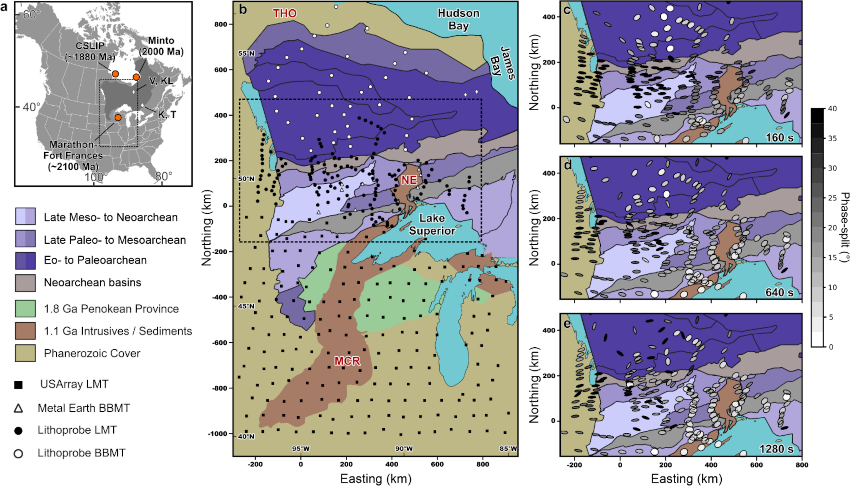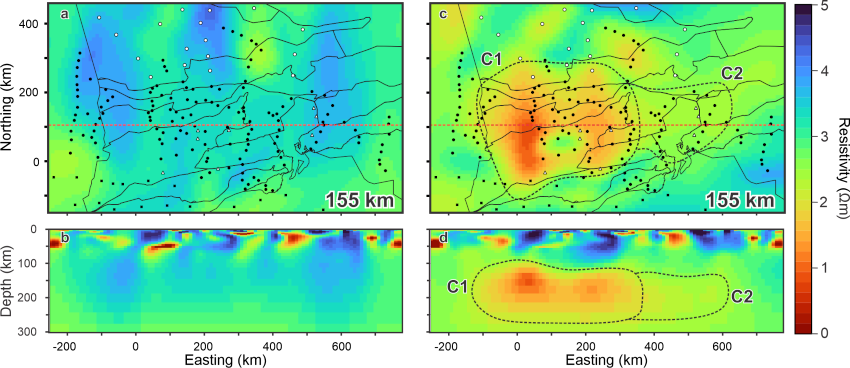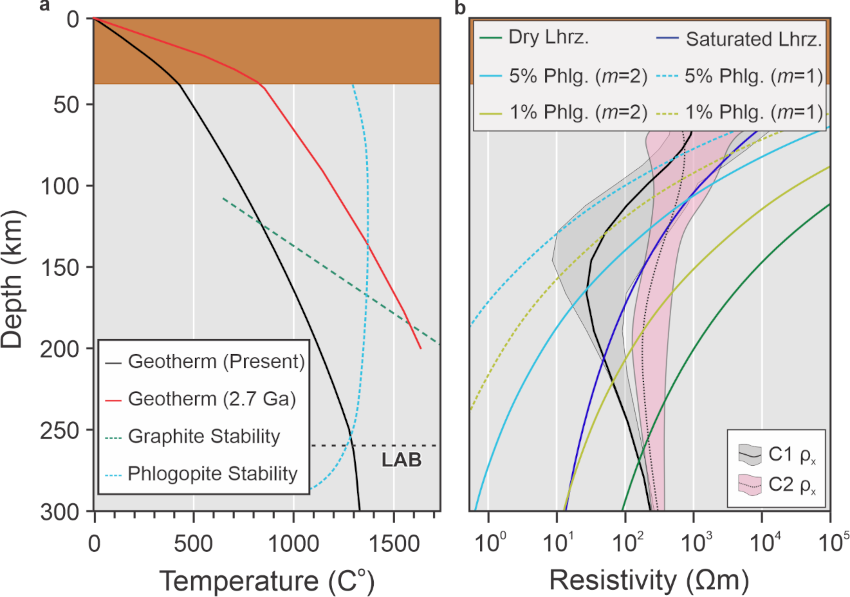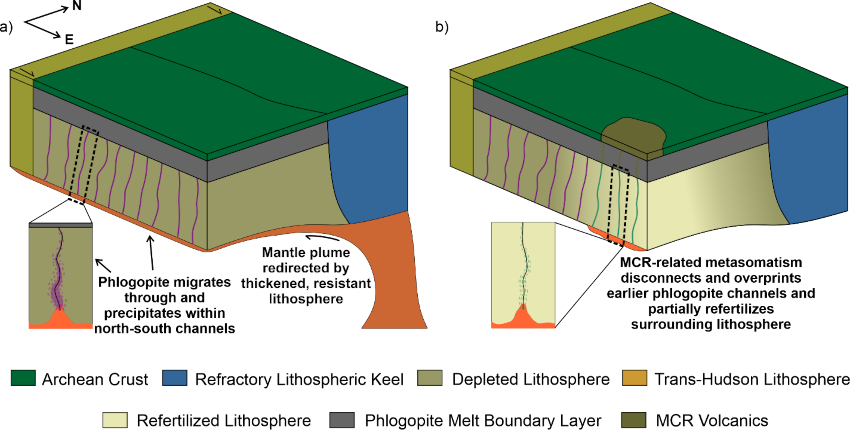August 2025 LIP of the Month
Subvertical (N-S-trending) phlogopite bearing dyke-like channels in the lithospheric mantle of the SW, Superior craton: link to stresses produced plume-generated LIPs
Extracted and modified from:
Roots, E.A., Hill, G.J., Frieman, B.M., Smith, R.S., Craven, J.A., Snyder, D.B., & Calvert, A.J. (2025). Channelized metasomatism in Archean cratonic roots as a mechanism of lithospheric refertilization. Nature Communications 16, 7701. https://doi.org/10.1038/s41467-025-62912-6
Abstract
Continental-scale magnetotelluric (MT) and seismic surveys have been used to investigate cratonic lithosphere; in this study (Roots et al. 2025), a new 3D anisotropic inversion is presented, revealing the resistivity structure of the lithospheric mantle of the SW Superior craton. The results indicate a layer of electrical anisotropy at depths of ~100-200 km with a N-S conductive direction interpreted to represent mantle lithosphere that has been metasomatized by fluorine-rich phlogopite-bearing fluids/melts along preferentially oriented channels.
The preferred N-S orientation is enigmatic, but could have a structural interpretation, and may be linked to horizontal compression exerted by the Trans Hudson Orogen, and the 1885-1870 Circum-Superior Large Igneous Province (LIP).
Introduction
Continental-scale magnetotelluric (MT) and seismic surveys have been used to investigate cratonic lithosphere as the physical properties they are sensitive to are able to identify compositional and thermal heterogeneities, as well as fluctuations in hydration levels1,2. Typical cold, depleted cratonic lithosphere is characterized by high seismic velocities and electrical resistivities. Conversely, low velocities and resistivities may be indicative of metasomatized lithosphere containing elevated hydrogen concentrations within nominally anhydrous minerals (NAMs), accessory minerals such as fluorine-rich phlogopite3–5, and/or interconnected grain-boundary graphite1,6. The complex deformational histories of cratonic regions often result in seismic anisotropy, which is typically attributed to lattice-preferred orientation of the minerals that develop due to strain accumulated during craton construction and/or present-day plate motion7,8. However, the generation and manifestation of electrical anisotropy within cratonic lithosphere remains enigmatic. Anisotropy within the asthenosphere9 and lithosphere10 of tectonically active regions is generally ascribed to some combination of interconnected melt and aqueous fluids – mechanisms which are not applicable within cold, stable lithosphere1.
The Superior Craton of Canada is the world’s largest Archean craton and forms the core of the North American continent (Fig. 1). The southwestern portion of the Superior Craton (hereafter referred to as the SW Superior) is comprised of largely ~east-trending terranes, generally thought to have been amalgamated at ~2720–2680 Ma via a series of accretionary events11. Subprovinces of the SW Superior generally young to the south, with the northern-most subprovinces forming an ancient proto-cratonic core against which the constituent terranes or subdomains accreted (Fig. 1b). Post-accretionary magmatism and deformation is recorded throughout the SW Superior12,13, with the cessation of major tectono-thermal events occurring at ~2600 Ma. The SW Superior remained internally stable through Paleoproterozoic episodes of continental growth along its margins including the 1900–1800 Ma Trans-Hudson Orogeny14 (THO) and Penokean Orogeny15. The THO resulted in ~25 km of east-west shortening across the crust of the SW Superior16. Roughly coeval with the THO-related deformation was the emplacement of the circum-Superior large igneous province (CSLIP)17, a series of largely mafic-ultramafic belts which were emplaced around the edges of the Superior Craton, with only minor dike intrusions within the craton interior. Due to the synchronicity and localization of magmatism to the craton margins, the CSLIP is inferred to be the result of a mantle plume which was deflected by the thick, refractory cratonic keel beneath the Superior Craton17,18. The most recent tectono-magmatic event which may have affected the SW Superior is the ~1.1 Ga Mid-Continent rift (MCR), a failed rift system which nearly fractured the North American Craton19. While MCR-related magmatism was largely focused along the two rift arms south of the Superior Craton, contemporaneous emplacement of igneous rocks that form the Nipigon Embayment (Fig. 1b) suggests that this region may represent the third rift arm of an MCR triple-junction20.
The lithosphere of the SW Superior has been studied extensively using a variety of seismic methods. Several studies have revealed a high-velocity lithosphere, generally interpreted as ancient and strongly depleted, between the western cratonic margin and the Nipigon Embayment. Greatly reduced seismic velocities beneath and to the east of the Nipigon Embayment were inferred to be the result of lithospheric modification during the MCR8,21,22. MT stations deployed as part of the Lithoprobe project revealed a similar signature in MT phase data around the Nipigon Embayment23; however, the lithospheric-scale resistivity structure of the SW Superior remains enigmatic. Recent 3D resistivity modelling studies revisited this dataset revealing curvilinear conductive and resistive bands which trend sub-parallel to major terrane boundaries, interpreted as the combined signatures of the accretionary processes which formed the crust of the SW Superior and subsequent post-orogenic extension and magmatism24. However, the modelled resistivity structure within the lithospheric mantle was dominated by artefacts of electrical anisotropy, obfuscating interpretation at mantle depths.
A new 3D anisotropic inversion is presented, revealing the resistivity structure of the lithospheric mantle of the SW Superior. The resulting resistivity volume identifies a layer of high electrical anisotropy at 100–200 km depth, spatially coincident with a region of strong seismic anisotropy as resolved by shear-wave splitting26 and seismic anisotropy tomography11. Considering the electrical, seismic, and geothermal properties of the region, the anisotropic layer is interpreted as preferentially north-south oriented phlogopite-bearing domains emplaced within the lithospheric mantle as a result of Proterozoic metasomatism and subsequent overprinting as a result of Mid-continent rift related magmatism.

Figure 1: Station and phase tensor maps of the study area. a) Map of North America (grey) and the Superior Craton (dark grey). Red circles indicate inferred focal points of Proterozoic mantle plumes (after ref. 25). White diamonds indicate xenolith suites (K – Kirkland Lake; T – Tamiskaming; V – Victor; KL – Kyle Lake). b) Map of the western Superior (modified from ref. 26) including the MT stations used in this study. Solid black lines denote craton and subprovince boundaries. Black dashed lines indicate the primary area of interest shown in Figure 2. NE – Nipigon Embayment; MCR – Mid-Continent Rift.
Results
Depth slices and E-W cross-sections through the 3D anisotropic resistivity model are shown in Figure 2. At crustal depths the anisotropic model is approximately isotropic (ρx≅ρy) with similar resistivities and geometries to that of the original isotropic model24, and so are not shown nor discussed here. The lithospheric mantle of the SW Superior is characterized by moderate to high degrees of electrical anisotropy, with low and high resistivities along the N-S and E-W orientations, respectively. Depths of 100–250 km are generally resistive (>1000 Ω·m) along the E-W axis (ρy)throughout the model (Fig. 2a). Resistivities along the N-S axis (ρx) are considerably lower; a large conductive body, C1, (ρxof 10–100 Ω·m) extends from the western edge of the craton to just west of the Nipigon Embayment (Fig. 2b). The region defined by C1 has a corresponding anisotropic ratio (defined as ) of 10–100. Anisotropic ratios decrease to ~10 within C2; in this region, ρy remains relatively high (>1,000 Ω·m) while ρx increases to 100–300 Ω·m (C2). The top of the anisotropic layer varies, but on average is at a depth of 100–120 km. Above this depth, the uppermost mantle of the SW Superior is moderately resistive (ρx, ρy >500 Ω·m), with geometries that largely reflect smearing / smoothing of lower crustal structures due to the inability of MT data to image directly beneath highly conductive bodies27.

Figure 2: Resistivity slices through the anisotropic model showing plan view slices at 155 km depth and E-W slices through the preferred anisotropic model showing a) the E-W oriented ρy resistivities, b) N-S oriented resistivity ρx, and East-west slices are taken through the red dashed lines in a) and b). All slices show only the primary area of interest (dashed box in Figure 1b).
Discussion
The electrical anisotropy within the SW Superior is inferred to be indicative of macroscopic structures at scales below the resolving power of MT data. At the depth range considered, MT data are sensitive to structures on the order of a few tens of kilometres; however, it is assumed that at lithospheric mantle depths and pressures, these ~N-S structures most likely correspond to channels where conductive phases were focused along intragranular spaces28 and/or isolated to <1 cm wide metasomatic dike channels29,30. Accordingly, the modelled ρy is taken to represent the approximate resistivity of the ‘normal’ depleted cratonic lithosphere, while ρx corresponds to conductive phases emplaced along ~N-S oriented structures. Typical cratonic lithosphere is highly resistive due to progressive depletion through a protracted history of high-grade metamorphism and melting events1,31. Metasomatism due to tectono-magmatic events (e.g., subduction, mantle plumes) and/or passive asthenospheric melt percolation into the lithosphere32 can lead to a locally refertilized mantle. These regions may be detectable using MT data due to elevated concentrations of some incompatible elements which have greatly reduced resistivities relative to that of depleted lithosphere, such as fluorine3–5.
Metasomatized lithosphere containing realistic volumes (<10%)33 of variably interconnected fluorine-rich phlogopite is able to reproduce the range of ρx found within both C1 and C2 (Fig. 3b). Phlogopite is a common indicator of mantle metasomatism34 and has been observed within xenolith samples across the Superior Craton35. Thus, phlogopite emplaced along N-S channels provides the most plausible explanation for the observed electrical anisotropy within the SW Superior.

Figure 3: a) Approximate geothermal conditions at present-day (black line) and at 2700 Ma (red line; from ref. 54) overlaid by the stability fields of graphite and phlogopite. Black dashed line indicates the LAB depth estimated by this geotherm. b) Volume-averaged resistivity-depth profiles within the C1 and C2 anomalies overlaid by calculated resistivity-depth profiles for lherzolite (Lhrz.) with varying water content, phlogopite (Phlg.) content, and phlogopite interconnectivity (m=1 is perfectly connected, m=2 is partially connected).
The apparent modification of the metasomatized channels by MCR-related activity at ~1100 Ma places a lower bound on the age of the N-S channels. Furthermore, while the exact thickness of the anisotropic layer is poorly resolved due to the shielding effect of conductors on MT data27, model sensitivity testing suggests it likely extends from ~100 km to at least 160–190 km. Phlogopite is stable36 to 1200–1400 °C, well within present-day cratonic conditions at the relevant depth range; however, geothermal conditions of the SW Superior were significantly hotter following its formation than they are today37, precluding the formation and long-term stability of phlogopite at depths greater than ~140 km based on the assumed Archean geotherm (Fig. 3a). Secular cooling of the lithosphere at an average rate of 100–150 °C/Ga38,39 increases the maximum depth of stability of phlogopite by 20–40 km/Ga. Thus, while initial formation of the metasomatized channels at depths of 100–140 km may have occurred during or shortly after the formation of the SW Superior at ~2700 Ma, 500–1000 Ma of lithospheric cooling is required for phlogopite to remain stable at depths of 160–190 km, placing a conservative upper bound on the age of emplacement at ~2200 Ma.
Mantle metasomatism and phlogopite emplacement has been linked to a variety of geodynamic processes including subduction4,40, mantle plume activity and/or melt pooling along the lithosphere-asthenosphere boundary (LAB)5, and lithospheric delamination3. However, these processes are generally inferred to lead to pervasive metasomatism across the affected regions and correspondingly isotropic geophysical anomalies. Therefore, it is unclear whether the channelized metasomatism revealed within the SW Superior requires a pre-existing or contemporaneously generated lithospheric fabric41 to focus melts and fluids into subvertical, N-S structures, or if such channels may nucleate and propagate spontaneously via recurrent and/or focused melt interaction at the base of the lithosphere2,32. In either case, consideration of the evolving geothermal conditions of the SW Superior following its construction and the stability of phlogopite discussed earlier suggests the locus of tectono-magmatic activity which occurred along the margins of the western Superior during the mid-Proterozoic (2200–1800 Ma), including the THO and Penokean orogeny as well as several mantle plumes (Fig. 1), provides the most plausible explanation.
The preferred interpretation involves impingement of a mantle plume along the northern border of the western Superior, possibly related to the emplacement of the CSLIP17,25, occurring contemporaneously with the onset of ocean closure along the western and northwestern borders of the craton during the THO42. If an N-S fabric is required for channelization of metasomatic fluids, it may have been formed as a result of THO-related E-W shortening and coeval mantle plume activity. In this case, fluid infiltration and resultant metasomatism may have initiated at the base of the lithosphere in a distributed manner (i.e., pervasive metasomatism without a specific preferred orientation), with coeval E-W shortening leading to preferential localization of fluids in N-S oriented domains perpendicular to the shortening axis. Such a process would lead to a positive feedback system wherein preferential fluid flow (and precipitation of conductive minerals which result in the observed anisotropy) would progressively channelize within the otherwise depleted, refractory lithospheric mantle43,44.
With the exception of the Pickle Crow dike swarm18, there is little evidence of Proterozoic magmatism within the interior of the SW Superior. This is consistent with the apparent termination of the anisotropic layer at ~100 km depth, suggesting that upwards migration of metasomatic fluids was inhibited in the mid-lithosphere, likely due either to the stalling and crystallization of ascending melts at solidus conditions2,45 or an inability to breach an impermeable boundary layer (e.g., an eclogite layer inferred at a depth of 100–120 km46). The former seems to be the more likely explanation, as the subsequent ~1.1 Ga MCR magmatism responsible for disconnection and overprinting of the precipitated phlogopite (Fig. 4b) also resulted in the emplacement of a significant volume of magmatic rocks within the crust19.

Figure 4: Schematic diagram illustrating the proposed mechanism of emplacement and structure of the metasomatized channels imaged within the lithosphere of the western Superior Craton. a) A ca. 1.9 Ga mantle plume impinges along the thickened, depleted lithosphere which comprises the northern cratonic core and is deflected southward. Pooling of melts at the base of the LAB results in gradual percolation of metasomatic fluids into the lithosphere forming phlogopite, possibly channeled into N-S weak zones which formed as a result of E-W compression during the Trans-Hudson Orogen. b) Subsequent melting and magmatism related to the ca. 1.1 Ga mid-continent rift overprints the phlogopite within the N-S channels and refertilizing the surrounding lithosphere.
The imaged resistivity structure is well-constrained within the primary study area, however, additional long-period MT data across the Superior Craton are required to determine the full spatial extent of the anisotropic region, and thus further constrain the timing and geodynamic processes responsible for the observed anisotropy. If similar geo-electric signatures are observed within other preserved cratonic regions, then they may represent processes which are critical to cratonic evolution. Such heterogeneities resulting from modification of stable lithosphere can facilitate the onset of craton instability and ultimately destruction47,48. Conversely, local networks of channels such as those inferred here may not significantly impact cratonic rheology compared to widespread pervasive metasomatism49, and the introduction of fluids into deep lithospheric shear zones has been suggested as a contributing factor to the long-term stability of cratonic lithosphere50. Furthermore, if the imaged anisotropic layer is a result of CSLIP-related mantle plume activity, then it represents a previously unobserved aspect of the CSLIP within the Superior Craton.
References
1. Selway, K. On the Causes of Electrical Conductivity Anomalies in Tectonically Stable Lithosphere. Surv Geophys 35, 219–257 (2014).
2. Aulbach, S., Massuyeau, M. & Gaillard, F. Origins of cratonic mantle discontinuities: A view from petrology, geochemistry and thermodynamic models. Lithos 268–271, 364–382 (2017).
3. Skirrow, R. G., van der Wielen, S. E., Champion, D. C., Czarnota, K. & Thiel, S. Lithospheric architecture and mantle metasomatism linked to iron oxide Cu-Au ore formation: Multidisciplinary evidence from the Olympic Dam region, South Australia. Geochemistry, Geophysics, Geosystems 19, 2673–2705 (2018).
4. Comeau, M. J., Becken, M. & Kuvshinov, A. V. Imaging the whole-lithosphere architecture of a mineral system—geophysical signatures of the sources and pathways of ore-forming fluids. Geochemistry, Geophysics, Geosystems 23, (2022).
5. Özaydın, S., Selway, K., Griffin, W. L. & Moorkamp, M. Probing the southern African lithosphere with magnetotellurics , Part II , linking electrical conductivity, composition and tectono-magmatic. J Geophys Res Solid Earth 127, e2021JB023105 (2022).
6. Thiel, S. & Heinson, G. Electrical conductors in Archean mantle-Result of plume interaction? Geophys Res Lett 40, 2947–2952 (2013).
7. Yuan, H. & Romanowicz, B. Lithospheric layering in the North American craton. Nature 466, 1063–1068 (2010).
8. Foster, A., Darbyshire, F. & Schaeffer, A. Anisotropic structure of the central North American Craton surrounding the Mid-Continent Rift: Evidence from Rayleigh waves. Precambrian Res 342, 105662 (2020).
9. Pommier, A. et al. Experimental constraints on the electrical anisotropy of the lithosphere-asthenosphere system. Nature 522, 202–206 (2015).
10. Wannamaker, P. E. et al. Fluid generation and pathways beneath an active compressional orogen, the New Zealand Southern Alps, inferred from magnetotelluric data. J Geophys Res 107, 2117 (2002).
11. Percival, J. A. et al. Geology and tectonic evolution of the Superior Province, Canada. in Tectonic Styles in Canada: The Lithoprobe Perspective (eds. Percival, J. A., Cook, F. A. & Clowes, R. M.) 321–378 (Geological Association of Canada, Special Paper 49, St John’s, NF, Canada, 2012).
12. Corfu, F., Stott, G. M. & Breaks, F. W. U-Pb geoehronology and evolution of the English River Subprovince, an Archean low P-high T metasedimentary belt in the Superior Province. Tectonics 14, 1220–1233 (1995).
13. Whalen, J. B., Percival, J. A., McNicoll, V. J. & Longstaffe, F. J. Geochemical and isotopic (Nd-O) evidence bearing on the origin of late- to post-orogenic high-K granitoid rocks in the Western Superior Province: Implications for late Archean tectonomagmatic processes. Precambrian Res 132, 303–326 (2004).
14. Hoffman, P. F. United Plates of America, the birth of a craton: Early Proterozoic assembly and growth of Laurentia. Annu Rev Earth Planet Sci 16, 543–603 (1988).
15. Schulz, K. J. & Cannon, W. F. The Penokean orogeny in the Lake Superior region. Precambrian Res 157, 4–25 (2007).
16. Percival, J. A. & West, G. F. The Kapuskasing uplift: a geological and geophysical synthesis. Can J Earth Sci 31, 1256–1286 (1994).
17. Ciborowski, T. J. R. et al. A mantle plume origin for the Palaeoproterozoic Circum-Superior Large Igneous Province. Precambrian Res 294, 189–213 (2017).
18. Minifie, M. J. et al. The northern and southern sections of the western ca. 1880Ma Circum-Superior Large Igneous Province, North America: The Pickle Crow dyke connection? Lithos 174, 217–235 (2013).
19. Stein, S. et al. Insights from North America’s failed Midcontinent Rift into the evolution of continental rifts and passive continental margins. Tectonophysics 744, 403–421 (2018).
20. Hinze, W. J. & Chandler, V. W. Reviewing the configuration and extent of the Midcontinent rift system. Precambrian Res 342, 105688 (2020).
21. Frederiksen, A. W., Bollmann, T., Darbyshire, F. & van der Lee, S. Modification of continental lithosphere by tectonic processes: A tomographic image of central North America. J Geophys Res Solid Earth 118, 1051–1066 (2013).
22. Ola, O. et al. Anisotropic zonation in the lithosphere of Central North America: Influence of a strong cratonic lithosphere on the Mid-Continent Rift. Tectonophysics 683, 367–381 (2016).
23. Ferguson, I. J. et al. Geoelectric response of Archean lithosphere in the western Superior Province, central Canada. Physics of the Earth and Planetary Interiors 150, 123–143 (2005).
24. Roots, E. A. et al. Constraints on growth and stabilization of the western Superior Craton from inversion of magnetotelluric data. Tectonics 43, (2024).
25. Ernst, R. & Bleeker, W. Large igneous provinces (LIPs), giant dyke swarms, and mantle plumes: Significance for breakup events within Canada and adjacent regions from 2.5 Ga to the present. Can J Earth Sci 47, 695–739 (2010).
26. Frieman, B. M. et al. Insight into Archean crustal growth and mantle evolution from multi-isotope U-Pb and Lu-Hf analysis of detrital zircon grains from the Abitibi and Pontiac subprovinces, Canada. Precambrian Res 357, 106136 (2021).
27. Chave, A. D. & Jones, A. G. The Magnetotelluric Method: Theory and Practice. (Cambridge University Press, Cambridge, 2012). doi:10.1017/CBO9781139020138.
28. Snyder, D. B. & Lockhart, G. Does seismically anisotropic subcontinental mantle lithosphere require metasomatic wehrlite-pyroxenite dyke stockworks? Lithos 112, 961–965 (2009).
29. Havlin, C., Parmentier, E. M. & Hirth, G. Dike propagation driven by melt accumulation at the lithosphere-asthenosphere boundary. Earth Planet Sci Lett 376, 20–28 (2013).
30. Fowler, A. C. & Scott, D. R. Hydraulic crack propagation in a porous medium. Geophys J Int 127, 595–604 (1996).
31. Sleep, N. H., Ebinger, C. J. & Kendall, J. M. Deflection of mantle plume material by cratonic keels. Geol Soc Spec Publ 199, 135–150 (2002).
32. McKenzie, D. Some remarks on the movement of small melt fractions in the mantle. Earth Planet Sci Lett 95, 53–72 (1989).
33. Li, Y., Jiang, H. & Yang, X. Fluorine follows water: Effect on electrical conductivity of silicate minerals by experimental constraints from phlogopite. Geochim Cosmochim Acta 217, 16–27 (2017).
34. Safonov, O., Butvina, V. & Limanov, E. Phlogopite-forming reactions as indicators of metasomatism in the lithospheric mantle. Minerals 9, 1–18 (2019).
35. Snyder, D. B. et al. Multidisciplinary modelling of mantle lithosphere structure within the Superior Craton, North America. Geochemistry, Geophysics, Geosystems 22, (2021).
36. Frost, D. J. The stability of hydrous mantle phases. Rev Mineral Geochem 62, 243–271 (2006).
37. Jaupart, C., Mareschal, J., Bouquerel, H. & Phaneuf, C. The building and stabilization of an Archean Craton in the Superior Province, Canada, from a heat flow perspective. J Geophys Res Solid Earth 119, 9130–9155 (2014).
38. Michaut, C. & Jaupart, C. Nonequilibrium temperatures and cooling rates in thick continental lithosphere. Geophys Res Lett 31, 1–4 (2004).
39. Michaut, C., Jaupart, C. & Mareschal, J.-C. Thermal evolution of cratonic roots. Lithos 109, 47–60 (2009).
40. Förster, M. W. & Selway, K. Melting of subducted sediments reconciles geophysical images of subduction zones. Nat Commun 12, 1–7 (2021).
41. Vauchez, A., Tommasi, A. & Barruol, G. Rheological heterogeneity, mechanical anisotropy and deformation of the continental lithosphere. Tectonophysics 296, 61–86 (1998).
42. Corrigan, D., Pehrsson, S., Wodicka, N. & de Kemp, E. The Palaeoproterozoic Trans-Hudson Orogen: a prototype of modern accretionary processes. Geological Society, London, Special Publications 327, 457–479 (2009).
43. Le Roux, V., Tommasi, A. & Vauchez, A. Feedback between melt percolation and deformation in an exhumed lithosphere-asthenosphere boundary. Earth Planet Sci Lett 274, 401–413 (2008).
44. Kourim, F. et al. Feedback of mantle metasomatism on olivine micro–fabric and seismic properties of the deep lithosphere. Lithos 328–329, 43–57 (2019).
45. Rader, E. et al. Characterization and petrological constraints of the midlithospheric discontinuity. Geochemistry, Geophysics, Geosystems 16, 3484–3504 (2015).
46. Altoe, I., Eeken, T., Goes, S., Foster, A. & Darbyshire, F. Thermo-compositional structure of the north-eastern Canadian Shield from Rayleigh wave dispersion analysis as a record of its tectonic history. Earth Planet Sci Lett 547, 116465 (2020).
47. Liu, L. et al. Development of a dense cratonic keel prior to the destruction of the North China Craton: Constraints from sedimentary records and numerical simulation. J Geophys Res Solid Earth 124, 13192–13206 (2019).
48. Wenker, S. & Beaumont, C. Effects of lateral strength contrasts and inherited heterogeneities on necking and rifting of continents. Tectonophysics 746, 46–63 (2018).
49. Bedle, H., Cooper, C. M. & Frost, C. D. Nature versus nurture: Preservation and destruction of Archean cratons. Tectonics 40, 1–38 (2021).
50. Lee, C. T. & Chin, E. J. Cratonization and a journey of healing: From weakness to strength. Earth Planet Sci Lett 624, 118439 (2023).
